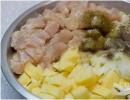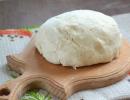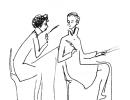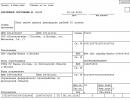Echidna where. Australian echidna (lat.
The echidna is an animal that resembles a porcupine in appearance, lays eggs like a bird, carries its young in a pouch like a kangaroo, and feeds like an anteater. Together with the platypus, this animal belongs to mammals that lay eggs.
Habitat
The echidna (animal), whose habitat extends only to Australia and Tasmania, can also live in captivity. It adapts well to any environment, so today it can be found not only in its original environment, but throughout the world.
Appearance

The echidna animal, the photo of which is presented, has a length of about 40 centimeters. Her back is covered with fur and needles. The head is relatively small and immediately merges into the body. The mouth is presented in the form of a tube-shaped beak, in a small hole of which there is a long sticky tongue. The beak is the main organ because vision is very poorly developed.
The animal moves on four short five-toed paws, which are distinguished by their muscularity. There are long claws on the fingers, and a five-centimeter claw grows on the hind paw, with which the individual combs its quills. The short tail is also covered with needles.
The echidna (animal) described here is a squat, spiny little mammal that is very adept at digging and has a long, tube-shaped beak.
Way of life
In the subtropical zone (Australia), echidnas behave more actively in summer nights. During the hottest hours of the day, they sit in the shade and rest. With the onset of darkness, animals feel the coolness and come out of their hiding places.
In cold areas of the mainland, frost is possible. In this case, echidnas slow down their vital activity until the onset of heat. Animals are not species that fall into hibernation. But in winter they can still fall asleep for a certain time.
They usually lead a nocturnal or twilight lifestyle. During the day they hide in cool places. Such shelters can be natural depressions in the soil, tree hollows, or bushes.
Echidna is an animal that has fantastic agility. This helps him dig the ground and get his food.
Nutrition

The main food for the animal is ants. With the help of their beak, echidnas skillfully dig the ground and obtain insects from termite mounds and anthills.
When an animal discovers an anthill, it immediately begins to dig it with sharp claws. The work does not stop until a deep tunnel is dug until the hard outer layer of the structure is destroyed.
The echidna (animal) sticks a long tongue into the tunnel, which is attacked by many biting ants. All that remains is to quickly return the tongue to the mouth along with the food. Besides the ants in digestive system soil, sand, and tree bark fall in.
Such nutrition is very important for a mammal that lives in arid zones. With ants, the echidna receives 70% of its moisture. Anteaters and armadillos survive in the same way.
If there is enough food in the habitat of mammals, they do not change it. If necessary, they can go several kilometers away.
Reproduction
IN ordinary life The echidna is a solitary animal. Communication with other individuals occurs only during the mating season. In order for them to use special trails that are marked with a specific smell.
Behavior during the mating period is not fully understood. It is only known that after fertilization, the female produces an egg no more than 15 millimeters in diameter. Next, she places it in the pouch using the tail and peritoneum. Scientists do not know cases of laying two or more eggs, but it is also impossible to talk about the rule of one egg.
Echidna is a marsupial. A female's pouch does not count permanent body like a kangaroo. It appears as a result of tension in certain muscles. Moreover, if you give the female a sedative, this organ will disappear in a matter of minutes.

A hatchling measuring 12 millimeters in size emerges from the egg in the pouch. It is unadapted to independent life: it is covered with primary skin, blind, and feeds on its mother’s milk. He lives in the bag until he begins to weigh about 400 grams.
Method of feeding a baby echidna
While in the pouch, the cub does not leave it until the mother decides to pull it out. He feeds on her milk, which has a pinkish color and a very thick consistency. In this way it is similar to the nutritional mixture of rabbits and dolphins.
Milk enters the bag through numerous holes from special glands. The baby licks it off. The nutritional qualities of the mixture allow you not to adhere to a strict feeding schedule. This is important when the mother takes the baby out of the pouch and hides it in a shelter.
Methods of protection

The main means of defense are a shield with needles and claws. The animal has no natural enemies. But there are known cases when they attacked echidnas and ate them along with a shield of needles. One day a dead python was discovered with the spiny animal stuck in it.
When sensing danger, the echidna (a cautious animal) very quickly begins to dig the ground around itself and within minutes disappears into the hole, leaving only its needles visible. When on a hard surface, it curls up into a ball, hiding its muzzle and beak. The last means of defense is a foul-smelling liquid, released in case of serious danger to the one who decided to disturb him.
If you look at an echidna, then most likely this animal will remind you of a hedgehog that for some reason has mutated. But these two species of animals are in no way closely related. The echidna's closest relative is actually the platypus. Appearance is only one of the common links between these two species of animals.
Zoological researchers working at the Research Center wildlife(town of Pelican Lagoon on Kangaroo Island, South Australia) shared fascinating information about these animals. These are the secrets.
Echidnas and their babies
The echidna belongs to the category of mammals, but this animal does not belong to the category of viviparous animals. Interestingly, when the animal reproduces, it lays eggs in a burrow. At the same time, the echidna has thick fur, and it feeds its babies with milk. The echidna and platypus, which form a group called monotremes, are the only mammals that reproduce in this unusual way.
The animal lays eggs in a special bag. This is not a permanent pouch of skin, like a kangaroo's, but a pseudopocket that develops before eggs are laid.
The baby hatches from the egg after 10 days. The baby, called a puggle, lives there for about 50 days until it begins to grow spines. After this, the mother begins to dig a hole for him, where he will grow stronger.
Although the animal feeds its offspring with milk, the female does not have nipples. Puggle stimulates milk production from an area that contains many special pores.
Do echidnas and anteaters have anything in common?
No, they have nothing in common. Echidnas are sometimes mistakenly classified as spiny anteaters. These animals are not related in any way to anteaters, but they collect food in a similar way.
The animals use their long sticky tongue to pull insects out of their nests. The Latin genus name for the short-tailed echidna, Tachyglossus, means "quick tongue." Echidnas do not have teeth, but they are able to crush food through their mouths, unlike anteaters, which swallow it whole, not crushed. The main food for the animal are worms, mollusks, ants, and beetles. In order to get food for itself, an animal can even destroy an anthill. The echidna has the strength to move a large stone and even knock it over in order to get food.
Species of echidnas
There are two types of echidnas: short-beaked and long-beaked. Long-beaked echidnas are found only in New Guinea, while short-beaked echidnas live in the same area and in Australia. An adult short-beaked echidna typically weighs about 8 pounds.

Curious characteristics
What interesting facts exist about these animals?
- Echidnas do not look like very active animals. Their range of movement in the habitat can be up to 200 acres.
- The echidna is depicted on the Australian five cent coin.
- The animal's egg is about the same size as an Australian 5 cent coin or a US coin.
- Echidnas and platypuses have lower body temperatures than any other mammal, ranging from 86 to 90 degrees Fahrenheit.
- They belong to the order of monotremes. They have a cloaca, like birds and reptiles. However, this hole has a multi-purpose purpose: for feces, urine, oviposition and fertilization.
- The male reproductive organ has four heads. Mating of individuals can last from 30 minutes to two hours.
- The echidna does not like the company of its relatives. More often the animal is in splendid isolation. The animal is jealous of its personal territory and will most likely be very angry if anyone dares to encroach on its hunting area.
- Despite the fact that the echidna's body is motionless and thick, this animal manifests itself as excellent swimmer. He can even cross a large body of water.
- Echidna has unusually acute vision. She quickly notices danger and tries to hide in bushes or rocky areas. If the enemy finds an animal there, then the echidna begins to burrow into the ground at very high speed. Only its needles remain on the surface. Sometimes an animal, like a hedgehog, curls up into a ball. The animal performs a similar action only on level ground, into which it cannot burrow.
- The echidna's enemies include monitor lizards, foxes, and wild dogs. These animals are capable of driving the animal to open space and attack her. And even if the echidna curls up into a ball, this is unlikely to save it from death, since the animal pursuing it can attack from the abdomen.
Echidna, despite his appearance, which resembles a cross between an anteater and a hedgehog, is actually the closest relative. This is another mammal that is capable of laying eggs.

The echidna family includes 3 genera: true echidnas (lat. Tachyglossus), vipers (lat. Zaglossus) and the now extinct genus Megalibgwilia. Prochidnas used to have 3 species, but now only 1 remains. Among the true echidnas, the Australian (Latin: Tachyglossus aculeatus) and the Tasmanian (Latin: Tachyglossus setosus) are distinguished.
 Australian echidna(lat. Tachyglossus aculeatus)
Australian echidna(lat. Tachyglossus aculeatus) Already from the name of the animal we can learn about its habitat. In addition to Australia, Tachyglossus aculeatus is found in Tasmania, New Guinea, and also on small islands in Bass Strait. Australian echidnas can live in almost any part of the mainland, regardless of the landscape. Their home can become like rain forests, and dry areas, both mountains and plains. Even in cities they are not that uncommon.
 Habitat of the Australian echidna
Habitat of the Australian echidna True, echidnas do not tolerate heat and cold well because they do not have sweat glands. IN hot weather they become lethargic, and when low temperatures hibernate, which can last 4 months. During this period, they use up their subcutaneous fat reserves.

Externally, the Australian echidna, like the Tasmanian one, resembles big hedgehog with an elongated muzzle like an anteater. Its entire body, except for the abdomen and muzzle, is strewn with many sharp and hard needles. The head is covered with thick hairs.

The length of this animal does not exceed 45 centimeters, and its weight does not exceed 5 kg. It is difficult to understand where the head ends and the body begins, since the neck is very short, which is a definite advantage for the echidna. She, like a hedgehog, curls up into a ball in case of danger, exposing huge 5-6-centimeter needles to the enemy.
 Echidna curled up in a ball
Echidna curled up in a ball At the same time, she tries to cover the only vulnerable spot on the body - the abdomen. For greater safety, the echidna can literally dig a small depression in the ground with its clawed front paws in just a minute. There she hides her muzzle and the front part of her body. When trying to pull it out of there, the echidna is securely fastened with its claws and needles to the walls of the pit, and therefore it will take a lot of effort to carry out this action.

The elongated muzzle is a modified “beak”, adapted for catching insects living in narrow crevices and burrows. In most cases, these are ants, which can be easily pulled out with a long sticky tongue, earthworms and other insects. The echidna's tongue can make up to 100 movements per minute. She doesn't have real teeth. The horny teeth located on the back of the tongue help it grind food.

Echidnas love to eat well and eat a lot. To do this, they can walk quite long distances without stopping and resting, which can reach 10-15 kilometers per day.
Like the platypus, the echidna’s “beak” is covered with special electroreceptors that allow it to detect the slightest fluctuations in the electric field of another animal. This feature is not observed in any other mammal.

The echidna's powerful claws are an excellent digging tool. Thanks to them, the animal easily creates a gap in the strong walls of termite mounds and anthills. Using elongated claws on their hind legs, echidnas clean their “spiny coat.”
Their eyesight is poor, but their hearing is excellent. But during night forays for food, they rely more on their sense of smell.

Echidnas are loners by nature. They unite into groups only at the beginning mating season, and then they run away again. They do not protect their territory and do not build permanent shelters. Echidnas are free and free to travel wherever they please. Any secluded place will suit them for sleep and rest, be it a hole between tree roots, a crevice between stones, a hollow fallen trees etc.
They move a little awkwardly. But they swim very well. Echidnas are able to swim across small bodies of water.

Reproduction of echidnas is a separate matter. With the onset of the mating season, a small group consisting of several males begins to form around one female. For some time they feed together and move from place to place. After 4 weeks of courtship, the struggle for the female begins, in which there will be only one winner.

After mating, the female goes to build a brood chamber, where 3-4 weeks after mating she lays a single egg 15-17 mm long and weighing 1.5 g. This is where the fun begins.
For a long time, scientists could not understand how the egg ends up in the brood pouch, since the female cannot roll it there with either her mouth or paws. The answer was found only in 2003 after a 12-year study of the behavior and life of echidnas in nature.

It turned out that before laying, the females begin to form a small fold in the area of the expected location of the future brood pouch. The female deftly curls up into a ball while laying an egg. In the area of the fold, a special sticky secretion begins to secrete, which attaches the egg to the stomach, and then the fold around it begins to gradually stretch.
 Baby echidna
Baby echidna After 10 days of “hatching”, a tiny baby emerges from the egg, 15 mm long and weighing 0.5 g. It is blind, naked, the hind legs are practically undeveloped, but on the front legs you can already see tiny fingers. Then it slowly moves to the front of the pouch, where the pores that secrete milk are located.
With the onset of spine growth (at about 2 months of age), the mother removes the baby from her pouch, builds a separate chamber for it and leaves it. True, not completely, once every 5-7 days she comes to feed him milk. This continues until 5-6 months of age, after which young echidnas begin independent life and go on their journey called “life”.

Echidnas are long-lived. In nature, their age can reach 16 years, and when kept in a zoo - 45 years.
These animals are not endangered. Perhaps because they are of little use to a person, but natural enemies, such as dingoes, foxes or monitor lizards cannot cause serious damage to their numbers.
The echidna can be found not only in nature, but also on the Australian 5-cent coin, as well as on postage stamps.
The echidna animal rarely reaches a size of more than 45-50 cm. Scientists have not been able to fully understand the origin of this animal. The Australian echidna lives in the west and eastern regions of the continent. There is a subspecies of this animal that lives on the island of Tasmania. The animal’s favorite habitat is dry bush (thickets of various shrubs) on rocky or loose soils.
The echidna animal rarely reaches a size of more than 45-50 cm
The animal belongs to the group of mammals that lay eggs. Echidna is a marsupial, like many representatives Australian fauna.She is featured on many stamps issued by Australia, as well as on the Australian 5 cent coin.
This small animal in nature has only one related species, which is called the echidna. This animal is larger than the echidna, both in weight and size. This species lives on the islands of New Guinea.
 The echidna is a marsupial, like many representatives of the Australian fauna
The echidna is a marsupial, like many representatives of the Australian fauna Appearance
The Australian echidna has small body, which is covered on the sides and top with needles up to 5-6 cm long. These protective devices are painted in brown or white shades. Between the needles the animal grows coarse brown fur. The animal is land-dwelling, but can swim. At the same time, the Australian echidna can overcome a wide body of water.
Echidnas look funny because of their slightly bulging eyes and thin muzzle, which is about 7.5 cm long. It has an almost circular cross-section.
At the very end of this long “nose” there is a narrow, small mouth (it opens 4-5 mm), inside of which there is a long flexible tongue. It is very sticky and allows the animal to hunt various worms and insects.
The length of the tongue reaches 22-25 cm, and the echidna can throw it out of its mouth 180 mm. The animal is capable of moving its tongue at high speed - 90-100 movements per minute.
How an echidna lives (video)
The echidna has a lot of thick and long hair around its ears. The ears themselves are practically invisible. The animal's tail is small. It looks like a small protrusion at the back and is covered in needles.
The weight of the animal can be from 2 to 5 kg, and the Tasmanian species is larger than its Australian counterpart.
Polar animal arctic fox
If there is no way to hide, then the Australian echidna curls up into a ball, like an ordinary hedgehog. The animal has excellent hearing, which compensates for it poor vision. The Australian echidna can detect weak electric fields generated by the movements of insects and worms. Only the platypus and echidna have such an electric locator. Since a mammal of this species is a monotreme animal, all waste from the body exits the animal through the cloaca.

Animal lifestyle
This animal practically does not dig holes. During the day unusual representative Australian fauna likes to hide in the hollows of various trees or sleep under their roots in the voids. At night the animal goes hunting. This animal feeds on the following invertebrates:
- It readily eats termites, tearing apart termite mounds with its claws.
- The animal's diet includes different types ants.
- If there are no insects mentioned above, then he can eat earthworms.
When the animal senses prey, it throws out a long, very sticky tongue from its narrow muzzle. The victim sticks to it and is then dragged into the echidna's mouth. Each animal has its own hunting territory.
Million Dollar Kitty: Caraquet is the most expensive cat in St. Petersburg

The animal has a large layer of subcutaneous fat, which helps the echidna endure the cold season. During such periods, the animal hibernates. Echidnas are able to dream, but when the temperature drops environment below 20°C or increasing to values more than 25°C, the sleep phase decreases or disappears completely.
Since the animal, when curled up into a ball in danger, cannot completely close itself with its spines, predators such as foxes and various types of wild dogs have learned to use this disadvantage of the echidna during hunting. This greatly reduced the number of Australian mammals. The echidna cannot escape from such an enemy, so it relies only on its needles.

Reproduction in nature
The echidna, like the platypus, belongs to rare species oviparous mammals. The mating season begins in winter, before which the animals live almost alone. Echidna reproduction occurs with the help of eggs. The males begin the courtship dance by circling around the female and throwing out the ground with their claws. Therefore, a trench is formed around the female echidna, the depth of which can reach 20-25 cm. The males begin to push each other out of the resulting hole. The female goes to the one who remains inside.
21-30 days after copulation, the female lays a soft-shelled egg, which she carefully places in the abdominal pouch. The dimensions of this egg are comparable to the dimensions of a pea. Scientists have not yet been able to figure out how the female attaches it to her pouch.
She incubates the egg for about 10 days. After the baby appears, the mother feeds it milk. It is released from special pores that are located in the milk field. This species of animals does not have nipples. A baby echidna licks the food mixture. He lives in his mother's pouch for 1.5-2 months. After this, its needles begin to form and grow, so it leaves the pouch. The mother digs a mink for her offspring, where he lives until the age of 7 months. Every 5 days, the female returns to the calf to feed him milk. After this, the young animal leaves the hole and begins to lead an independent lifestyle.
There is a creature on earth that is born from an egg, but feeds on its mother’s milk until it grows up. Today - the echidna animal and all the most interesting things connected with it.
"Double" of a porcupine. Animal echidna
Nature has created many unique creatures that do not resemble any other animal in their appearance. But it turns out that even such an unusual animal as a porcupine has a double in nature. Does anyone else really have the same spiky hair? The name of this “beauty with a spiked hairstyle” is echidna.
Echidnas are mammals. Like platypuses, echidnas belong to the order Monotremes. Today in nature there are only two varieties of this animal: the spiny echidna (this group includes the Australian echidna, Tasmanian echidna and Papuan echidna) and the woolly echidna (lives in the forests of New Guinea).
Appearance of the echidna
As mentioned above, the echidna is very similar in appearance to a porcupine. Its body is also covered with stiff hairs and sharp long needles, the color of which can be white, gray, black or brown.
Only, unlike the porcupine, average length The echidna's body is about 40 - 50 centimeters (but there are larger individuals - up to 55 centimeters). The animal weighs on average 7 kilograms.
 The echidna is an interesting animal with a funny face.
The echidna is an interesting animal with a funny face. The echidna's muzzle looks funny: instead of a nose and lips, it has a long “proboscis” called a beak. The animal has no teeth. The legs are short, but despite this, they are very strong. Thanks to this property, echidnas skillfully dig the soil.
The echidna's lifestyle and behavior
The echidna is a solitary animal. She is jealous of her territory and is unlikely to allow any of her own kind into her “hunting zone.” Although the animal’s body, at first glance, is heavy and not entirely suitable for swimming, the echidna moves calmly and easily by swimming. The animal is able to swim across even a large body of water. These animals do not have permanent housing.

Thanks to his acute vision, echidnas instantly notice danger and try to hide in thickets or in rock cracks. Well, if the enemy overtakes the echidna where there is no natural shelter, then the animal begins to bury its body into the ground with incredible speed, leaving only its traumatic needles on the surface. Another method of defense against natural opponents is curling up into a ball. Echidnas do this when the area is too open and the soil is hard to burrow into.
Echidna diet
The main food for this animal is termites, small mollusks, worms and ants. In search of “dinner,” an echidna can dig up an anthill and tear off the bark from trees that once fell and are now home to small insects. In addition, the animal is able to move and even turn over a stone to get food.
 The echidna used the “hedgehog” tactic; she covered the least protected parts of the body with her clawed paws
The echidna used the “hedgehog” tactic; she covered the least protected parts of the body with her clawed paws
The hunting process occurs in this way: having approached the prey, with the help of its long and sticky tongue, the echidna captures the prey, presses it to the palate in its mouth and crushes it.
Echidna reproduction and breeding of offspring
The echidna is popularly called the bird-beast. But why? This is because the echidna hatches its offspring using eggs and feeds its young with milk. This is such an unusual animal.

Three weeks after the mating season, the female echidna lays one egg. This egg has a very soft shell, so she carefully places it in her pouch and carries it for 10 days. And now, ten days later, it is born little cub but he's not ready yet adult life in the world of wild nature, because it is very weak. Therefore, for about fifty more days he lives in his mother’s pouch and eats her milk.
The female produces milk through pores located in the so-called milk fields. There are two such pores, but the echidna does not have nipples by nature. After 50 days, the baby’s needles begin to grow, so caring mother transplants it into a specially dug hole. The female herself goes hunting and comes to the mink once every 4 or 5 days to feed her baby milk. And this happens until the cub is seven months old.






